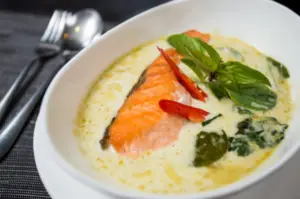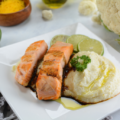Are you looking for a flavorful and nutritious dinner recipe that is both easy to make and perfect for those following a low-carb or keto diet?
Look no further than this Creamy Coconut Lime Salmon recipe! With its combination of tender pan-seared salmon fillets and a creamy coconut lime sauce, this dish is sure to become a family favorite.
In this article, I will guide you through the step-by-step process of making this delicious meal, provide alternative cooking methods for salmon, discuss the benefits of eating salmon, and offer some tips and tricks for making the most out of this recipe.
1. Ingredients and Preparation
To make this Creamy Coconut Lime Salmon recipe, you will need the following ingredients:
- 4 Salmon Fillets
- 1 tablespoon Coconut Oil
- 1 medium Shallot, finely chopped
- 3-4 Garlic Cloves, minced
- 1 cup Full-fat Canned Coconut Milk
- 1 teaspoon Dried Oregano
- 2 tablespoons Fresh Lime Juice
- 1 tablespoon Lime Zest
- 1 tablespoon Cornstarch
- Salt and pepper, to taste
- Fresh chopped cilantro, for garnish
- Extra lime slices, for garnish
Before you start cooking, make sure to season the salmon fillets with salt and pepper on all sides. This will enhance the flavor of the fish and ensure a well-seasoned final dish. Additionally, gather all the other ingredients and have them pre-measured and ready to use. This will help streamline the cooking process and prevent any last-minute scrambling.
2. Pan Searing the Salmon
The first step in making this Creamy Coconut Lime Salmon is pan searing the salmon fillets. Heat the coconut oil in a large non-stick pan over medium heat. Once the oil is hot, add the salmon fillets to the pan, skin side down. Allow the salmon to cook undisturbed for about 2-3 minutes, or until it turns golden brown and easily releases from the pan. Carefully flip the salmon fillets using a thin metal spatula and cook for an additional 2-3 minutes on the other side. At this point, the salmon may still be slightly undercooked, but don’t worry, as it will continue to cook in the sauce later on. Transfer the seared salmon fillets to a plate and set them aside.
3. Making the Creamy Sauce
To create the creamy coconut lime sauce, start by adding the finely chopped shallot and minced garlic to the same pan used to sear the salmon. Cook them over medium heat for 3-4 minutes, or until they soften and become fragrant. Meanwhile, in a small bowl, whisk together the coconut milk, dried oregano, fresh lime juice, lime zest, and cornstarch until well combined. This mixture will serve as the base for the creamy sauce.
4. Combining the Salmon with the Sauce
Pour the coconut milk mixture into the pan with the cooked shallot and garlic. Lower the heat to a simmer and season the sauce with salt and pepper to taste. Once the sauce is simmering, return the seared salmon fillets to the pan, ensuring that they are fully submerged in the sauce. Allow the salmon to cook in the sauce until it is cooked through and the sauce has thickened, which should take approximately 5-7 minutes. Cooking the salmon in the sauce not only adds flavor but also allows it to absorb the creamy and tangy coconut lime flavors.
5. Garnishing and Serving
Once the salmon is fully cooked and the sauce has thickened to your desired consistency, remove the pan from heat. Sprinkle the dish with fresh chopped cilantro and garnish with extra lime slices for added freshness and visual appeal. The vibrant green color of the cilantro and the bright citrus notes from the lime will complement the creamy coconut sauce and the tender salmon beautifully. Serve the Creamy Coconut Lime Salmon while hot and enjoy!
6. Alternative Cooking Methods for Salmon
While pan searing is the cooking method used in this recipe, there are several other ways to cook salmon, each with its own unique flavor and texture. Here are some alternative cooking methods for salmon:
- Grilled: Grilling salmon gives it a smoky and slightly charred flavor. Brush the salmon with oil or marinade to prevent sticking and grill it with the skin side down for added moisture and protection.
- Stovetop: Sautéing salmon on the stovetop is quick and easy. Heat some oil in a pan over medium-high heat and cook the salmon for a few minutes on each side until it reaches your desired level of doneness. You can also poach salmon by cooking it in a flavorful liquid, such as broth or wine, to infuse it with additional flavors.
- Oven Roasted: Roasting salmon in the oven is a simple and convenient method, especially when cooking multiple fillets at once. Preheat the oven to 350-400°F (175-200°C), place the salmon in a baking dish or on a sheet pan, and let it cook for about 20 minutes, or until it flakes easily with a fork.
- Broiling: Broiling salmon gives it a crispy and caramelized top without the need for flipping the fillets. Place the salmon on a broiler pan or a baking sheet lined with foil, and broil it on high heat for a few minutes until the top is golden brown and slightly charred.
Experimenting with different cooking methods can add variety to your salmon dishes and allow you to discover new flavors and textures.
7. The Health Benefits of Eating Salmon
Salmon is not only delicious but also highly nutritious. It is rich in protein, omega-3 fatty acids, vitamin B12, selenium, and choline. These nutrients offer numerous health benefits, including:
- Brain Function and Cognition: The omega-3 fatty acids found in salmon are essential for brain health, as they can improve brain function, cognition, and neurological health.
- Heart Health: The omega-3 fatty acids in salmon have been shown to reduce the risk of heart disease by lowering blood pressure, reducing inflammation, and improving overall cardiovascular health.
- Immunity Boost: Salmon contains selenium, a mineral that plays a crucial role in supporting a healthy immune system and protecting the body against oxidative stress.
- Weight Management: The high protein content in salmon can help increase feelings of fullness and reduce appetite, making it a great addition to a weight management or weight loss diet.
Incorporating salmon into your regular diet can provide you with these health benefits and more. It is recommended to consume salmon at least twice a week to reap the full nutritional advantages.
8. Tips and Tricks for Making Creamy Coconut Lime Salmon
Here are some tips and tricks to help you make the most out of this Creamy Coconut Lime Salmon recipe:
- Use Fresh Ingredients: Whenever possible, opt for fresh salmon fillets, fresh lime juice, and fresh herbs like cilantro. Fresh ingredients will enhance the flavors of the dish and provide the best results.
- Adjust Lime Juice to Taste: The amount of lime juice used in the recipe can be adjusted according to personal preference. If you prefer a more subtle citrus flavor, start with less lime juice and gradually add more to taste.
- Customize the Spice Level: If you prefer a spicier dish, you can add some chopped chili peppers or red pepper flakes to the sauce. Adjust the amount according to your desired level of heat.
- Meal Prep: This recipe is great for meal prepping. You can cook a larger batch of salmon and sauce, portion it into individual containers, and refrigerate or freeze for later use. Simply reheat the servings when ready to eat.
- Serve with Side Dishes: Creamy Coconut Lime Salmon pairs well with a variety of side dishes. Consider serving it with grilled vegetables, brown rice, quinoa, or other grains to create a well-rounded and satisfying meal.
By following these tips and tricks, you can elevate the flavors of this Creamy Coconut Lime Salmon recipe and make it your own.
9. Other Easy Salmon Recipes
If you enjoyed this Creamy Coconut Lime Salmon recipe, you may also be interested in trying out other easy salmon recipes. Here are some ideas to inspire your culinary adventures:
- Lemon Garlic Butter Salmon: A classic combination of flavors that never disappoints. This recipe features tender salmon fillets cooked in a tangy lemon garlic butter sauce.
- Teriyaki Glazed Salmon: A sweet and savory salmon dish that is bursting with Asian-inspired flavors. The teriyaki glaze gives the salmon a delicious caramelized coating.
- Honey Mustard Baked Salmon: A simple yet flavorful recipe that combines the sweetness of honey with the tanginess of mustard. Baking the salmon keeps it moist and tender.
- Dijon Herb Crusted Salmon: A sophisticated and herbaceous dish that features a crispy Dijon mustard and herb crust on top of tender salmon fillets.
- Mediterranean Grilled Salmon: A light and refreshing salmon dish that is marinated in a Mediterranean-inspired blend of herbs, lemon, and olive oil, then grilled to perfection.
These recipes, along with many others, provide different flavor profiles and cooking techniques to keep your salmon dinners exciting and varied.




